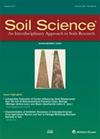The effect of tillage depth and traffic management on soil properties and root development during two growth stages of winter wheat (Triticum aestivum L.)
4区 农林科学
Q2 Agricultural and Biological Sciences
引用次数: 4
Abstract
Abstract. The management of agricultural soils during crop establishment can affect root development due to changes in the soil structure. This paper assesses the influence of tillage depth (250 mm, 100 mm, and zero tillage) and traffic management (conventional tyre pressure, low tyre pressure, and no traffic) on wheat root system architecture during winter wheat (Triticum aestivum L.) tillering and flowering growth stages (GS) at a long-term tillage trial site. The study revealed that zero-tillage systems increased crop yield through significantly greater root biomass (P<0.001), root length density, and deeper seminal rooting analysed using X-ray computed tomography (CT) (P<0.001) compared with trafficked treatments. In general, conventional-pressure traffic had a significant negative influence on the crop yield (P<0.01), root development (0.001), bulk density (P<0.05), and total soil porosity (P<0.05) of deep- and shallow-tillage conventional-pressure systems compared with no-traffic zero- and deep-tillage systems. Visual improvements in soil structure under zero-tillage conditions may have improved crop rooting in zero-tillage treatments through vertical pore fissures (biopores), enhancing water uptake during the crop flowering period. This study highlights the increasing implications of soil structural damage on root system architecture created by machinery traffic in crop production. Although the tillage method was less important, the constricted root systems were more pronounced in conventional-pressure shallow-tillage and deep-tillage systems, emphasizing the importance of using controlled-traffic farming methods to improve soil management and reduce the trafficked areas of agricultural fields.耕作深度和交通管理对冬小麦两个生育期土壤性质和根系发育的影响
摘要由于土壤结构的变化,作物育成期间的农业土壤管理会影响根系的发育。在一个长期耕作试验地,研究了不同耕作深度(250 mm、100 mm和免耕作)和交通管理(常规胎压、低胎压和不耕作)对冬小麦分蘖期和开花生长期根系结构的影响。研究发现,与常规处理相比,免耕系统通过显著增加根系生物量(P<0.001)、根长密度和更深的半生根(P<0.001)来提高作物产量。总体而言,常规压力交通对深耕和浅耕常规压力系统的作物产量(P<0.01)、根系发育(P< 0.001)、容重(P<0.05)和土壤总孔隙度(P<0.05)的影响显著低于无交通的零耕和深耕系统。免耕条件下土壤结构的视觉改善可能通过垂直孔隙裂缝(生物孔)改善免耕处理下的作物根系,增加作物开花期间的水分吸收。这项研究强调了作物生产中机械交通造成的土壤结构破坏对根系结构的影响越来越大。尽管耕作方式不太重要,但在常规压力浅耕和深耕系统中,根系收缩更为明显,这强调了使用控制交通的耕作方法来改善土壤管理和减少农田交通面积的重要性。
本文章由计算机程序翻译,如有差异,请以英文原文为准。
求助全文
约1分钟内获得全文
求助全文
来源期刊

Soil Science
农林科学-土壤科学
CiteScore
2.70
自引率
0.00%
发文量
0
审稿时长
4.4 months
期刊介绍:
Cessation.Soil Science satisfies the professional needs of all scientists and laboratory personnel involved in soil and plant research by publishing primary research reports and critical reviews of basic and applied soil science, especially as it relates to soil and plant studies and general environmental soil science.
Each month, Soil Science presents authoritative research articles from an impressive array of discipline: soil chemistry and biochemistry, physics, fertility and nutrition, soil genesis and morphology, soil microbiology and mineralogy. Of immediate relevance to soil scientists-both industrial and academic-this unique publication also has long-range value for agronomists and environmental scientists.
 求助内容:
求助内容: 应助结果提醒方式:
应助结果提醒方式:


